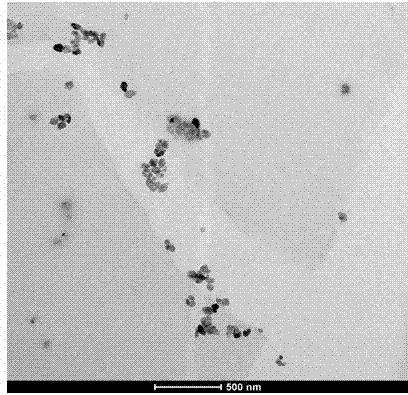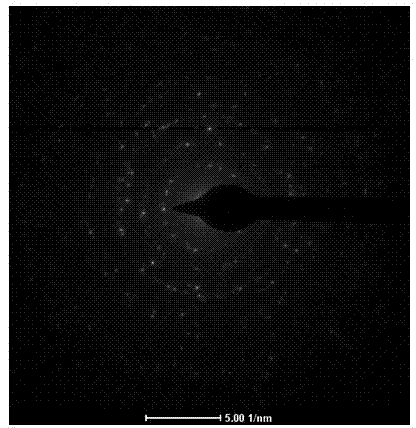Method for preparing grapheme/ ceramic nanocrystalline particle composite material with electrospinning-hydrothemal method
A composite material, graphene technology, applied in filament/thread forming, textile and papermaking, fiber processing and other directions, can solve the problem of product specific surface area reduction, etc., to achieve the effect of facilitating industrial production
- Summary
- Abstract
- Description
- Claims
- Application Information
AI Technical Summary
Problems solved by technology
Method used
Image
Examples
Embodiment 1
[0018] a. Weigh 0.4 g of PVP and dissolve it in 7 mL of ethanol solvent, then add 2.0 g of glacial acetic acid and 1 mL of isopropyl titanate, stir magnetically at 20 °C for 1 h at a speed of 350 rpm / min, and obtain an electric spinning solution.
[0019] b. Electrospinning was carried out at 20 °C and a humidity of 45%. The flow rate of the electrospinning solution was 10 mL / h, the DC voltage was 15 kV, and the spinning receiving distance was 15 cm to obtain TiO 2 / PVP composite nanofibers.
[0020] c. Weigh 20 mg of electrospun composite nanofibers, immerse them in an aqueous solution of 75 vol % acetic acid, and configure a solution with a mass concentration of 1 mg / mL. At this time, PVP is dissolved in the solution, and at the same time, the nanofiber branches TiO 2 nanoparticles.
[0021] d, according to graphene oxide: TiO 2 The mass ratio of PVP / PVP composite nanofibers is 100:1. Add 2 g of graphene oxide into the above solution and stir evenly with a glass rod.
...
Embodiment 2
[0026] a. Weigh 0.3 g of PVP and dissolve it in 4 mL of ethanol, then add 1 mL of hydrochloric acid and 5 mL of tetraethyl orthosilicate, and stir magnetically at 20 °C for 12 h at a speed of 500 rpm / min to obtain an electrospinning solution .
[0027] b. Electrospinning was performed at 35 °C and a humidity of 80%. The flow rate of the electrospinning solution was 0.3 mL / h, the DC voltage was 35 kV, and the spinning receiving distance was 35 cm to obtain SiO 2 / PVP composite nanofibers.
[0028] c. Weigh 5 g of electrospun composite nanofibers, immerse them in water, and configure a solution with a mass concentration of 0.5 g / mL. At this time, PVP is dissolved in water, and at the same time, the nanofibers branch into fine SiO 2 nanoparticles.
[0029] d, according to graphene oxide: SiO 2 / PVP composite nanofiber mass ratio is 1:100, 0.1 g graphene oxide is added to the above solution, and stirred evenly with a glass rod.
[0030] e. Transfer the above solution to a hydr...
Embodiment 3
[0034] a. Weigh 0.3 g of PVA and dissolve in 8 mL of distilled water, then add 2.0 g of glacial acetic acid and 1 g of zinc acetate, and stir magnetically at 90 °C for 24 h at a speed of 50 rpm / min to obtain an electrospinning solution.
[0035] b. Electrospinning was carried out at 30 °C and a humidity of 10%. The flow rate of the electrospinning solution was 0.3 mL / h, the DC voltage was 35 kV, and the spinning receiving distance was 35 cm to obtain ZnO / PVA composite nanofibers.
[0036]c. Weigh 10 g of electrospun composite nanofibers, immerse them in water, and configure a solution with a mass concentration of 0.5 g / mL. At this time, PVA is dissolved in water, and at the same time, the nanofibers are branched into fine ZnO nanoparticles .
[0037] d. Add 0.1 g of graphene oxide into the above solution according to the mass ratio of graphene oxide:ZnO / PVA composite nanofibers of 1:100, and stir evenly with a glass rod.
[0038] e. Transfer the above solution to a hydrotherm...
PUM
 Login to View More
Login to View More Abstract
Description
Claims
Application Information
 Login to View More
Login to View More - Generate Ideas
- Intellectual Property
- Life Sciences
- Materials
- Tech Scout
- Unparalleled Data Quality
- Higher Quality Content
- 60% Fewer Hallucinations
Browse by: Latest US Patents, China's latest patents, Technical Efficacy Thesaurus, Application Domain, Technology Topic, Popular Technical Reports.
© 2025 PatSnap. All rights reserved.Legal|Privacy policy|Modern Slavery Act Transparency Statement|Sitemap|About US| Contact US: help@patsnap.com



